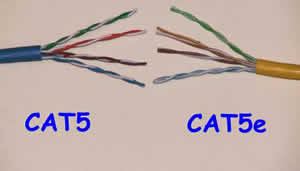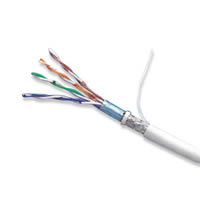Difference between Cat5 and Cat6 Cable
Key difference: Category 5, Cat 5 or Cat5, also Category 6, Cat 6 or Cat6 are both types of cables. They are both a type of twisted pair cable for carrying signals, used mainly for Ethernet computer networks. Cat5 is the older variation of the cables, especially as compared to Cat6. The Cat5 consists of four twisted pairs of unshielded copper wire. Cat6 is currently the most advanced of the three categories of cables. Similar to Cat5, the Cat6 is made up of four twisted pairs of copper wire. However, it works faster than the Cat5 or Cat5e and can support higher frequencies.
 Category 5, Cat 5 or Cat5, also Category 6, Cat 6 or Cat6 are both types of cables. They are both a type of twisted pair cable for carrying signals, used mainly for Ethernet computer networks.
Category 5, Cat 5 or Cat5, also Category 6, Cat 6 or Cat6 are both types of cables. They are both a type of twisted pair cable for carrying signals, used mainly for Ethernet computer networks.
Cat5 is the older variation of the cables, especially as compared to Cat6. The Cat5 consists of four twisted pairs of unshielded copper wire. The copper wires are terminated by RJ45 connectors. The cable is connected using punch down blocks and modular connectors. Cat5 supports frequencies up to 100 MHz and provides speeds up to 100 Mbps.
Cat5 is currently the most common cable used to facilitate Ethernets; however, Cat5 can be used for ATM, token ring, 10BASE-T, 100BASE-TX (Fast Ethernet), and 1000BASE-T (Gigabit Ethernet) networking. It addition to networking, Cat5 can also be used to carry signals such as telephony and video.
The Cat5 cables are unshielded. They rely on the twisted pair design and differential signaling for noise rejection. Cat5 cables are commonly connected using punch down blocks and modular connectors.
CAT5 cables contain four pairs of copper wire; however, Fast Ethernet communications only use two of the four pairs. The other two go unutilized. Hence, it can be said that the Cat5 was not meeting its full capabilities. Cat5 was then superseded by the Category 5e, also known as Cat5e or Cat 5e. The e in Cat5e stands for enhanced. Basically, Cat5e is the enhanced version of Cat5.
The Cat5e supports networking at Gigabit Ethernet, which means speeds up to 1000 Mbps or 1 Gbps. It does this by utilizing all four pairs of wires. Also, it is backward-compatible with ordinary Cat5. Both Cat5 and Cat5e are can be run 100 meters or 328 feet without requiring the use of a switch, which would extend the run of the cable.
 Cat6 is currently the most advanced of the three categories of cables. Similar to Cat5, the Cat6 is made up of four twisted pairs of copper wire. However, it works faster than the Cat5 or Cat5e and can support higher frequencies. The Cat6 provides speeds up to 10 Gbps and can support frequencies up to 250 MHz. It can do this, because it contains a particular structural difference, as compared to Cat5: a longitudinal separator. The longitudinal separator isolates each of the four pairs of twisted wire from the others. This reduces crosstalk, allows for faster data transfer and allows Cat6 to be much faster than Cat5. Additionally, Cat6 is also backward-compatible, which means that it can be effectively be used with Cat5 and Cat5e.
Cat6 is currently the most advanced of the three categories of cables. Similar to Cat5, the Cat6 is made up of four twisted pairs of copper wire. However, it works faster than the Cat5 or Cat5e and can support higher frequencies. The Cat6 provides speeds up to 10 Gbps and can support frequencies up to 250 MHz. It can do this, because it contains a particular structural difference, as compared to Cat5: a longitudinal separator. The longitudinal separator isolates each of the four pairs of twisted wire from the others. This reduces crosstalk, allows for faster data transfer and allows Cat6 to be much faster than Cat5. Additionally, Cat6 is also backward-compatible, which means that it can be effectively be used with Cat5 and Cat5e.
Cat6 has the advantage over Cat5, in being faster and more modern. However, it is not as widely used or adapted as Cat5. This is mainly due to the reason that Cat6 is more expensive than Cat5, and that majority of the people either do not use nor require a 10 Gigabit Ethernet.
Furthermore, Cat6 has been superseded by Cat6a. Cat6a provides speeds up to 10 Gbps and can support frequencies up to 500 MHz. Furthermore, Cat7 is currently in development. Cat6 and Cat6a can both be run 100 meters or 328 feet without requiring the use of a switch. However, Cat6 supporting 10 Gbps can be run 55 meters or 180.45 feet.
Image Courtesy: brucetambling.com, made-in-china.com









Add new comment